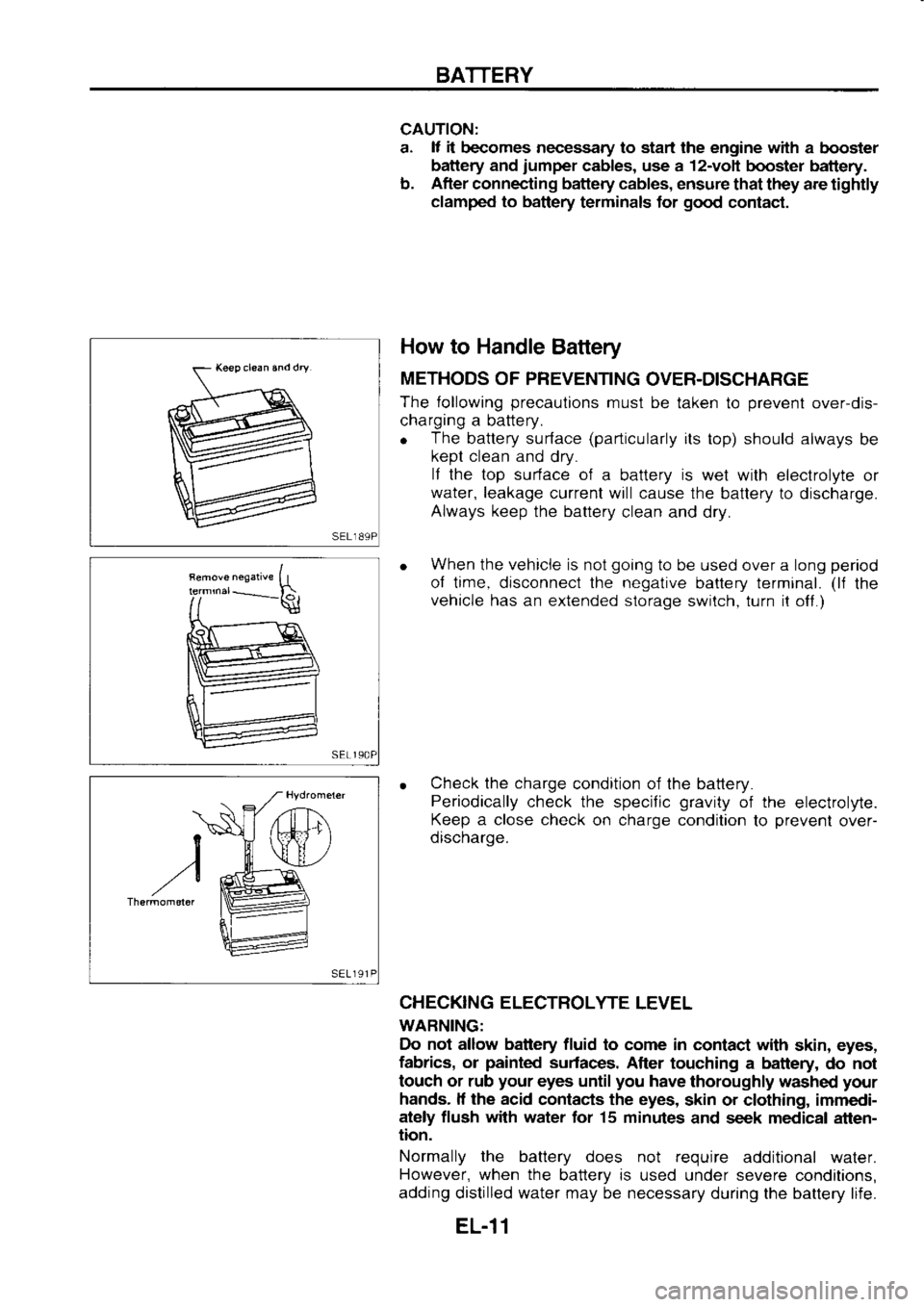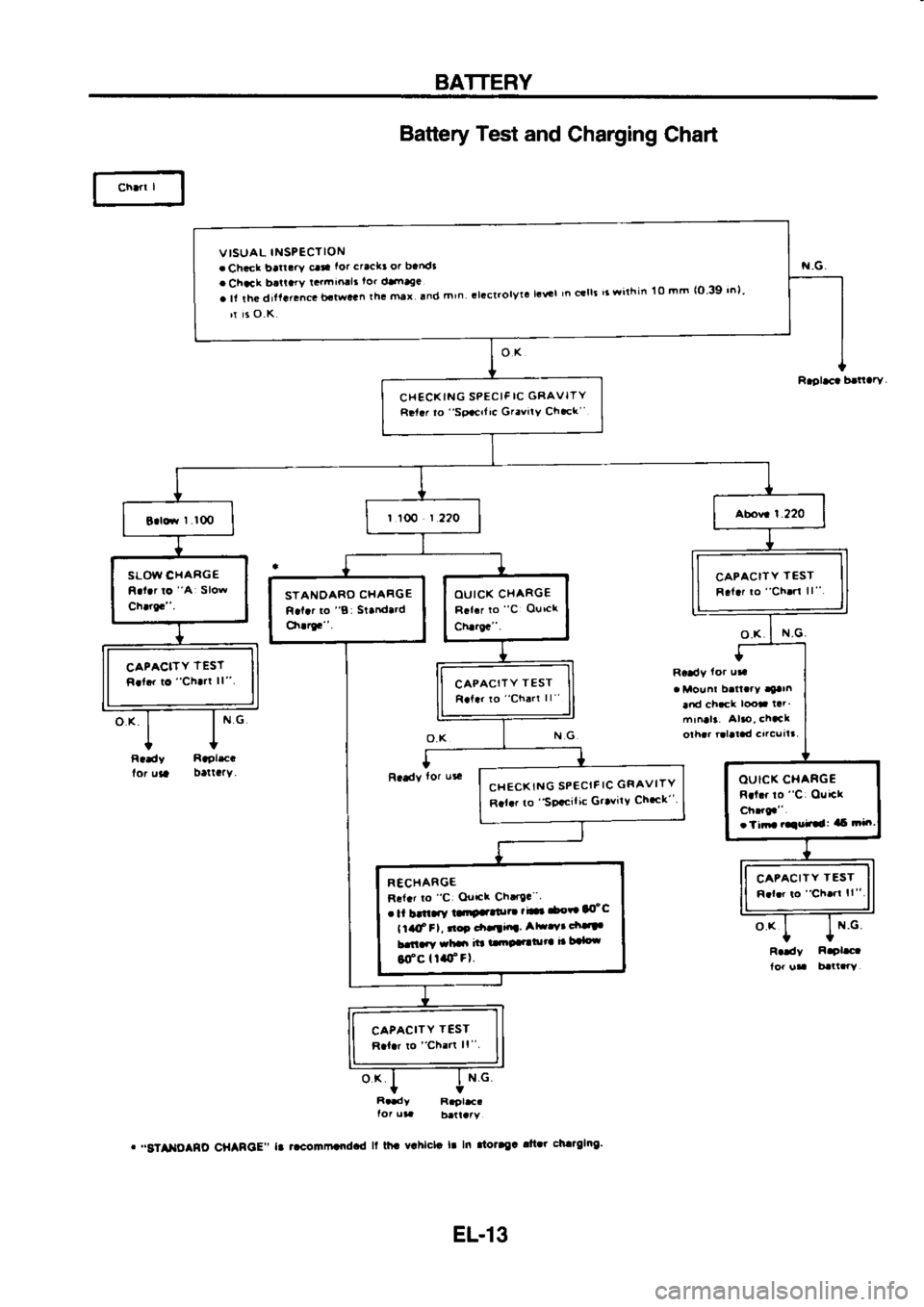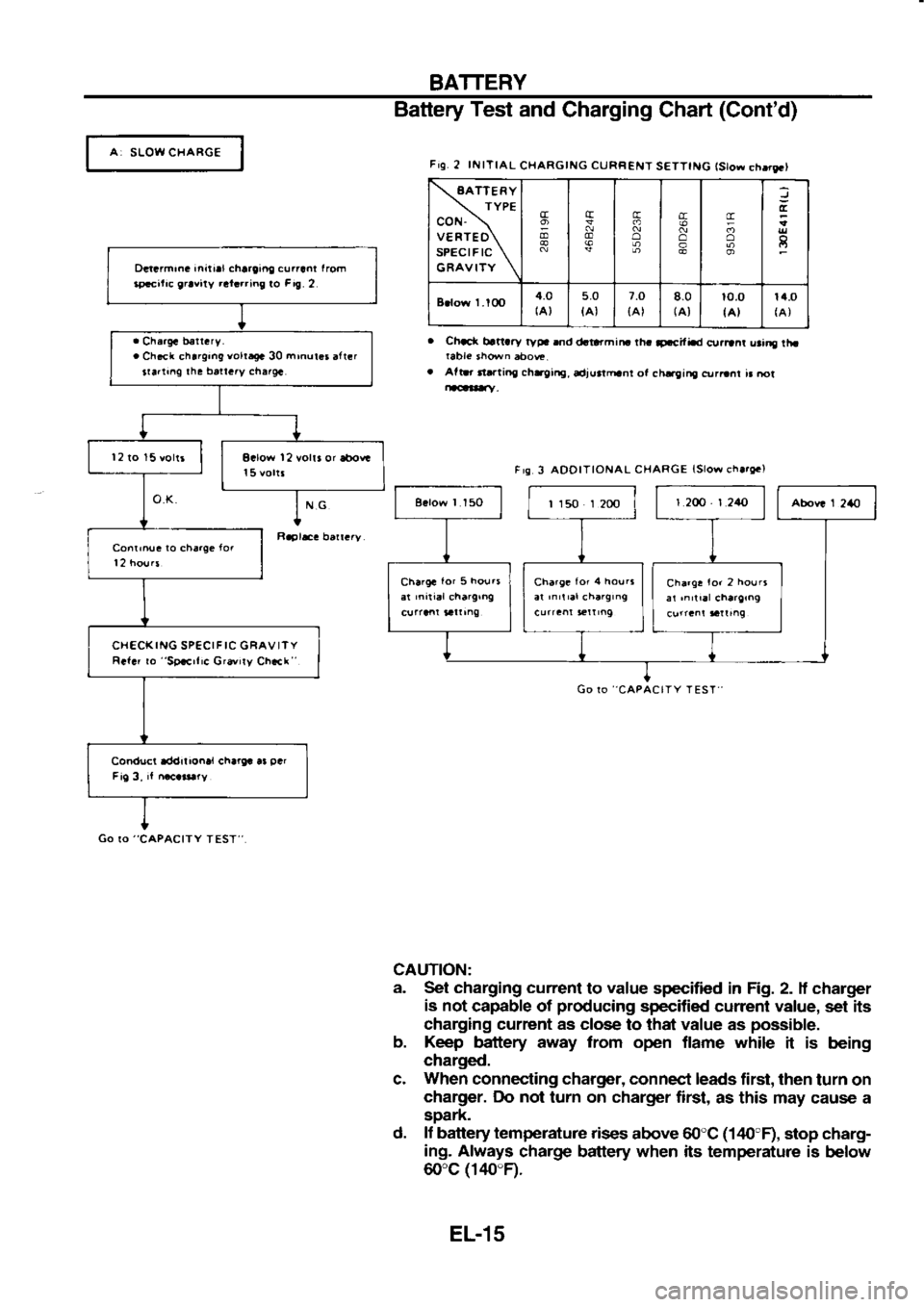Page 626 of 1254
TROUBLE
DIAGNOSES -dt
Elec{rical Components Inspection (Cont'd)
JE.C,U. lnsp€ctlon
tabl€
TEEii-Enm-iii:_l sANERY VOLTAGE
II] I1V)
Fadiaro, ran
Gra, (Lm*F8d) BATTEFY
VOLTACE
111 .
I4V)
Rad aro' ratr Gray (N
sh{pd) BATTERY
VOLTAGE (1
1 '
I4V)
SAnEFYVoLTAGE(ir. r4v)
EF & EC425
Page 913 of 1254
AN'I]-LOCK
BRAKING SYSTEM
COMTFOL UNIT
L@tlon: C{rer @NoL undd dash p5reL
Removal
ACTUATOB L Dlscon.ecibaterycable.
2. DEin b€ke lluid. Reler to changi.g arake Fluid" in
"CHECK AND ADJUSTMENT".
s. Apply dili66nl 6lor€d paint
to each p
p6
enn€.lor and
aclualor to prev€nl
incorccl conneclion.
l/xl
oisconnecl @nne.lor, brake p
pes
and
emove liring nuis and acluator grou.d
cable.
Us lbB nul sErch ro Emm lbE nul*
6. eetll nol
to d.mase erfde ol kake
I ih. &-tl.tor will not b6 iBr.ll.d dirElly
afi.r EmoEl, plug
bdc nuid inl€b .nd out-
let6 to p@nt
enterlnq du6t Into
etuaioi Insiallalion
Altor l.dalladon, 6ill br6k6 tuid. Th6n bled air.
F.fuT IO "CHECK AND ADJUSTMENT' 'Nd
"AIF
BIEEDING" BF.cdEly.
1. Tighten actuator grcund
cable.
2. Connel b.ak6 pip€s
tempoE ly.
5, Conne.t .on.ecior and battery €ble.
. Tighlen tlare nuts ot bake pipes
ro lh€ spec
BR-39
Page 1114 of 1254
STANDARDIZED
RELAY
Description
NORMAL OPEN, NORMAL
CLOSED AND
MIXED TYPE
RELAYS
Relays can mainly be divided into three
types: normal
open, normal closed
and mixed
type relays.
z
o
3
sEL881t-l
TYPE OF STANDARDIZED RELAYS
1L4
1T ...
1 t\,4ake
l Transler 2M
...................
2 t4ake
'1Nil | 18..................
1 Make 1
s1!
r
eatriq, 5M
BATTERY sriY
I
EL.3
Page 1122 of 1254

BATTERY
CAUTION:
a. lf
it
becomes neoessary to start the engine with
a booster
battery and jumper
cables, use a 12-volt
booster battery.
b. After
connec-ting battery cables,
ensure that they are tightly
clamped to batlery
terminals lor good
contact.
How to Handle
Battery
METHODS OF PREVENTING
OVER-DISCHARGE
The following precaulions
must be
taken to prevent
overdis-
charging a battery.
o The
battery surface (particularly
ils top) should always
be
kept clean and
dry.
lf the top surface of
a battery is
wet wilh electrolyte
or
water, leakage
current will cause the
battery to discharge.
Always keep
the battery
clean and dry.
When the vehicle is not going
to be used over a long period
ol time, disconnect the negative
battery terminal. (ll
the
vehicle has an extended storage
switch, turn it off.)
Check the charge
condition of the battery.
Periodically check the
specific gravity
of the
electrolyte.
Keep a close check
on charge condition
to prevent
over-
discharge.
CHECKING ELECTROLYTE
LEVEL
WARNING: Do not allow battery fluid
to come in contact with
skin, eyes,
fabrics, or painted
surfaces, After touching a
battery, do not
touch or rub your
eyes until you
have thoroughly washed your
hands. lf the
acid contacts the eyes,
skin or clothing, immedi-
ately flush with
water for 15 minutes
and seek medical atten-
tion.
Normally the
battery does not require
additional water.
However, when the
battery is used under severe
condilions,
adding distilled water may be necessary
during the battery life.
sEL
191
t
)
,r/ "
EL-11
Page 1123 of 1254

BATTERY
- No.mal
batia.y
____- S{rloharad b.riarv
Chrti't| volrrt
I
Charting csr..nr
I "_j:=
Ch.rginf Yolt.g.
Ch|rgin' curr.nl
Ogr.rion ol ch.rt How
to Handle Battery (Cont'd)
SULPHATION
When a baftery has
been left
unattended for a long period
of
time and has a specific gravity
ot less than 1.100, it will
be
completely discharged, resulting in sulphation on
the cell
plates.
Compared with a battery discharged under normal conditions,
the current flow in a "sulphated"
battery is not as smooth
although its voltage is high
during the initial
stage of charging,
as shown in
the figure
at the left.
SPECIFIC GRAV]TY CHECK
1 . Read hydrometer and thermometer indications
at eye level.
o When
electrolyte level is
too low,
tilt battery case to raise it
for easy measurement.
2. Convert into
specitic gravity
at 20'C (68"F).
Examole:
o When
electrolyte temperature is
35"C (95'F)
and specific
gravity of electrolyte is 1 .230, converted specific gravity
at
20'C (68'F)
is 1.240.
o When
electrolyte
temperalure is
0"C (32"F)
and specific
gravity of electrolyte is 1 .210,
converted specific gravity
at
20'C (68'F)
is 1 .196.
Rad
top Lvcl
with rcalc
)
Th6rmorn€t6a
Hydro.n t.r
e U
,-a
,rt a
Thsmoniatea
Conwrr.d !p.citic
er.vny (S20)
t
a t.$
|.2t
r.2t t.2a
l.z,
1.20 r.ta
t.ta
t.ta
t.t2
r.ro
||al t32t t50]
tat| tr]
Elactrolvta latnoaratura 'C
fF,
SEL197P
EL.l2
Page 1124 of 1254

BATTERY
Battery Test
and Charging Chart
o.K
o.K. N.G Rcady
tot
ura
. Mount batlary .earn
a.id ch.ck loot
lar'
mrnalt. Alao, chack
orhar r.latad o.curlt
o.K.
N,G.
o.K R.9l.cr
bfiarY.
N.G,
N,G
Radv lor ura Ra9l.c.
battary.
R.-vRtlact
N.G.
R..dy R.pl.E.
tor uat
br(arv
. 'STAIIDARO
CHABOE" la
..conmandad ll
th. vahlcla l.
In ttot'g"tltr ch"g|ng'
V
ISUAL INSPECTION
.Chcct batary cata lor
crack! or bat'tdt
. Chack ballary
t.rmrnalt tor
ctnagc
.|lthcditf.rlnc.b.tw.cnth.maxrndmlh.G|!ct.o|ytc|.*||nct||t'rwnhinl0mm(o-39inl. rt rs
O.K
CHECK ING
SPECIF IC
GRAVITY
Rrl.. ro 'Sp.cilic
Gr.v(y Ch.ck"
CAPACITY T€ST
R.l.r to
"Ch.rl ll '
SLOW
CXARGE
R.l.r to 'Ar
slow
Ch.rg.'. OUICK
CHARG€
Ft.l.r lo 'C
Ou|ck
Ch..ga".
STANOARO
CHARGE
R.l.r to
"B: St.ndard
c,r.rF .
CAPACITY T€ST
R.lcr to "Chart ll
CAPACITY TEST
R.{.. io "Ch..l
ll
OUICK CHARGE
Rrl.. !o "C:
Ouicl
Chrrta"
. tiir tlu-td: ta6
tri|r.
CH€CK
ING
SPCCIF IC
GRAVITY
R.l.r to "sgacilic
GravilY Ch'ck"
RECHARGE
Rclcr to 'Cr
Ourcl Ch.tg. .
. tt btna.Y |rtFa.aol?t ri-
-cvt 'dC
t rad
F
l, rrog dr4i.r.. Alt.v. clr'{'
b.rtaw th-r
in |.|rF?atuna i.
b'lot
8dC fiadFl. CAPACITY
TEST
n.1.. ro "Ch..r
ll
CAPACITY TEST
R.t.r to "Ch.n ll
EL.13
Page 1125 of 1254
BATTERY
Battery Test
and Charging Chart (Cont'd)
. Chd( b.nary
ryp. rnd
cb!.rmina th. F.cilLd
drrnnr urlllo rh. lolbwtnl
tab|.,
Fig. 1
OISCHARGING CURRENT
(Lo.d re5t6r)
cuiienr (A)
28819R
46824A
55D23R
80D268
95D31R
I15D31R 90
180 195
244
244
Tatr
ul|ng load taata.
Follow mrnut.crur!r'r
inrtrudion. io chck and
d.t.rmr^G rl ba[ary il Rrrd
losd
lrrtr. volt46
wh.n .p.citi.d dirch.rging
curr.ni {Fl.l.r ro Fi9.
I )
llow3 rhrough bait.ry lor
R..dy tor
u..
Go to nlri
ittp
EL-14
Page 1126 of 1254

BATTERY
A SLOW CHARGE Battery
Test
and Charging Chart (Cont'd)
F19. 2 lNlTlAL
CHARGING CURRENT
S€TT|NG lstow ch.rg.,
\8ATTERY TYPE
coN- \
VERTEO\
SPEC|F tC
\
GRAVITY \c!
t! tr
(D cc
o cc
o cc
o ft
Bdow I
.l0O 4.0
tA) 5.0
{a) 7.0
{A' 8.0
tAt lo.0
(At 14.O
Chact banary
ryp..nd drtrtmin
th.
,p.citht currant uriq
th.
tabl€ sho$rn abov?.
Aft r
rtrrting chrgirE,
sdjuttr.nt ol
chrging clJrrrnt ir no!
CAUTION:
a. Set charging current
to value
specified in Fig. 2. lf
charger
is not
capable of producing
specified current value,
set its
charging current as close
to that value as possible.
b. Keep
battery away lrom
open flame while
it is being
charged.
c, When connecting charger, connect leads
first, then
turn on
charger. Do not
turn on charger first,
as this may cause a
spark.
d. lf
battery temperature rises
above 60"C (140'F),
stop charg-
ing. Always
charge battery when its temperature is
below
60"c (140"R. Frs
3 ADOITIONAL CHARGE {Slow
ch.rg.)
Go Io ',CAPACIIY
TEST,'
r
150 1
200
Chsrgc to,
5 hou.s
Cha.g? lor
4 hourr
Charg! tor
2 hourt
ar 'nrlr.r
charoin9
Dctarmrna
Iniiral
charcant currant trom
rp.citic arrvily .ct..ring
to Fig.
2
. Cha.gc b€rt.ry.
. Ch.ck ch.rgan9 volt.g.
30 mrnurcr
altcr
rra.tinq tha
batla.y chrrgc
t2 ro l5
voltr Salow l2
voltr or sbor€
15 volr3
Conr'nu. !o
cha.o. to.
l2 hou.5
CHECKING SPECIF IC GRAV IT Y
Ralcr to "Soacrlrc
Gravrtv Chact'
Conduct addriional
charga a! par
Fig 3. il
nacaatary
Go to ,,CAPACITY
TEST,
EL-15